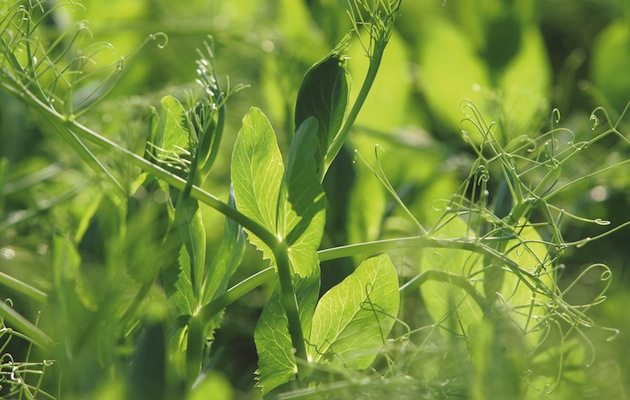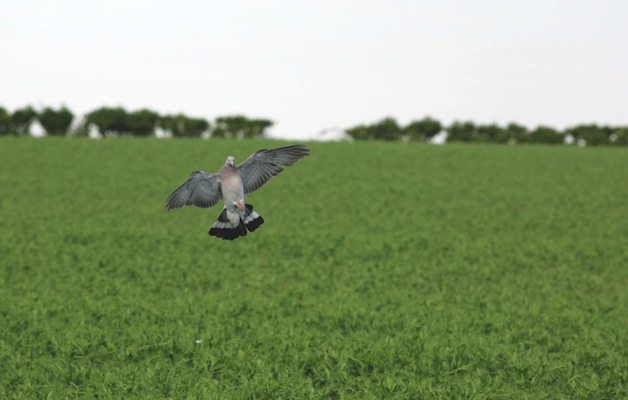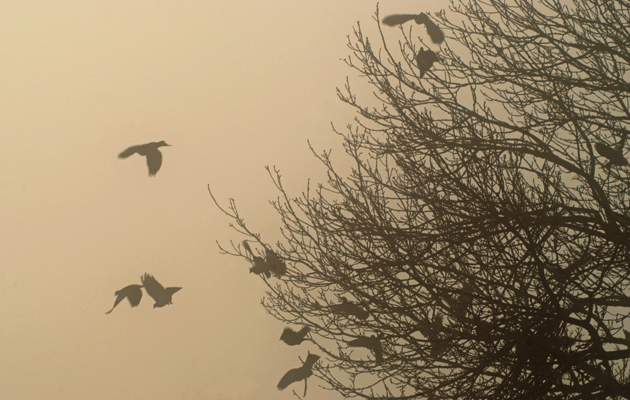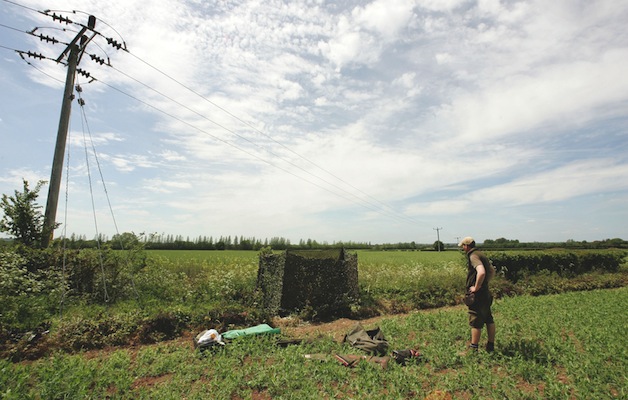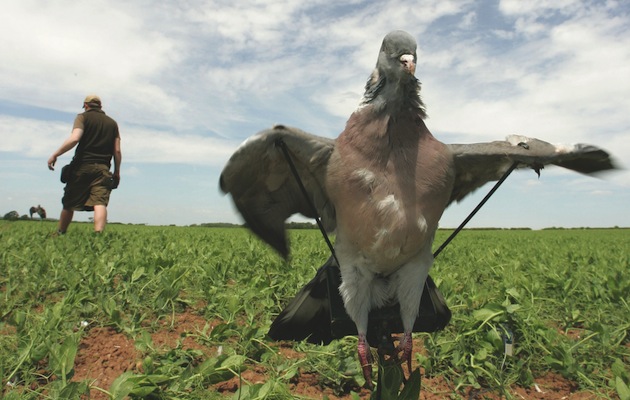Peas and pigeon shooting
Peas are a great crop for picking off the pigeon - but success still requires fieldcraft
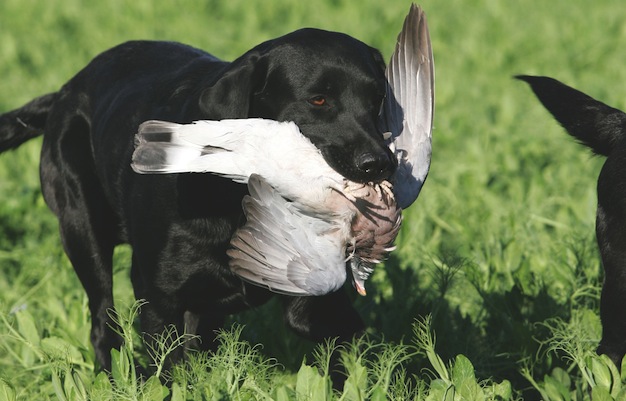
Black labrador retrieving pigeon
It has been a very strange — and disappointing — couple of months with regard to pigeon shooting. From the start of the year I was having a pigeon-shooting bonanza, with good numbers being shot over winter rape and birds decoying brilliantly. The trend continued into the spring drillings.
I was doing so well that I thought it was going to be a very good year
Then, towards the end of the spring drillings and into May it all changed. It was as though the birds just switched off. I haven’t experienced a May/early June like it for quite a long time. I would go as far as to say it’s the worst May I’ve experienced. May is not an easy month because there’s so much variety in green crops and buds for the birds to eat, but I would usually get a few good outings and plenty of small ones. I think I went four or five weeks without shooting a single pigeon.
There wasn’t much change in early June, either. The reason I felt so disappointed is that I had some brilliant pigeon foods to shoot over, including peas, spring rape, mustard and clover. If you could pick crops to have in your area at this time of year these would be the ones, but the pigeon were not playing ball. On my recon trips I walked hedgerow after hedgerow and plenty of woodland, and there were many birds in the area — just nothing on the wing. All the crops, such as peas and spring rape, were taking a long time to grow and this could only be down to the soil temperature. On speaking to many farmers we all agreed that soil temperatures were very low.
Weather factor
The low soil temperatures got me thinking and I started to study the weather closely, as I thought this would have something to do with the behaviour of the birds. Though the daytime temperatures fluctuated, at night they were incredibly low and continued to be so into June. I felt certain this had to be affecting the way the birds were behaving. Were they trying to conserve energy until they could move on to laid barley? I thought that if we had a prolonged hot spell they would move out to feed.
The temperatures warmed up slightly and I decided that the main crop I would shoot over would be the peas, which had started to grow, but there was still no pigeon activity. We had a brief warm period and the birds started to move. I thought this could be the turnaround.
I had a good outing with my friend Rob Swift following a couple of very hot days in early June. It was as though the birds had just “turned on” and for two days they fed on the peas in the late afternoon. Despite a wet start on the third day, they decoyed well but all were local to the area. We finished on 78.
A week later we shot the same field again. This time we thought we were in for a good outing — all was looking well. Rob couldn’t get to me for the end of the session in the late afternoon (thanks to a slight falling-out with a broken sprayer). It was a perfect day for shooting over peas: warm and with a light breeze. Plenty of birds had been coming to the field the previous day, so I would have put money on a 100-plus outing.
And yet, surprisingly, it never really got going all afternoon. There were some sporadic moments when we had a quick 10-shot and then nothing. We ended on a disappointing 72 picked.
What was interesting about these outings, particularly the first, was that every single bird shot could only be described as hard winter thin. The birds were in worryingly poor condition coming into peak breeding time. However, on the second outing they had improved slightly following the week of warmer weather. Let’s hope that by the time you are reading this their condition will have improved greatly.
The Pigeon Shooter’s Code
The conditions were great for an afternoon’s pigeon flighting. We decided to hop into photographer Oli Lees’s pickup as I…
Pigeon shooting in the fog
The plan was to try a couple of hundred woodies feeding on high ground above my house, but under what…
Tom’s top tips for shooting over peas
Don’t over-shoot your ground
Peas, as pigeon shooters know, are a favourite with woodpigeon. This year many farmers are growing peas again — a definite change in farming practices with the three-crop rule and green covercrops replacing stewardship schemes. Peas are a fantastic all-rounder for the pigeon shooter and can provide sport from drilling to harvest. Once peas start to appear from drill they will grow quickly and your local pigeon population will begin to show increased interest.
When managing the pigeon population over peas, it is important to leave an interval between your outings. If you over-shoot your ground, birds will become difficult to decoy and you will end up as a mobile bird scarer, pushing birds from one part of the field to the other.
This is no help to the farmer when it comes to controlling the damage that would be caused.
Conduct reconnaisance to establish timings
At this time of year, pigeon won’t be heading out early to feed and the warmer the day the later they will arrive at their chosen spot. I normally make three visits when deciding timing and conditions. I tend to watch midday and try to beat the arriving birds to the field. This could be a long wait, but it is an important stage.
Once you have established when birds start to arrive, make a note of your timings and the weather then leave them in peace.
A visit later in the afternoon will help you decide on the correct hide position as numbers will have built up on the chosen part of the field. A last visit will help give an indication of how long they are willing to feed and the possible numbers coming to the field.
As the crop of peas grows and starts to flower, don’t be disheartened if the birds are concealed — it is nearly impossible to see feeding birds in a crop of peas especially when the peas start to flower and really begin to grow. Instead, pay careful attention to birds on the wing.
Tailor your decoying to the conditions
How you decoy the crop will depend on the stage of growth. If the crop is low in growth set the cradles level with the crop just to aid invisibility. Bamboo canes are great for setting birds up on cradles on a taller crop.
Flappers work brilliantly over a taller crop of peas as the movement of the white wing bars just at the top of the crop is a real draw. Again, bamboo poles can help to give you a bit more height. Keeping the flappers level with the taller crop is important as, from a distance, it looks realistic.
Magnets work too, and I have noticed that moving your magnet during a session keeps birds decoying well, especially if you are shooting a very local population that may be on a second visit to the field. Effectively, you are showing the birds something different.
Don’t be frightened to try different approaches, even during the session. If birds are starting to behave as though they have seen the picture once before, simply try a different picture.
With peas, birds feed in quite close proximity to each other and will stay where they land to feed. This is mainly due to the crop being difficult to move through. If the birds move they will do so by flying and not walking. This is why flappers work so well.

